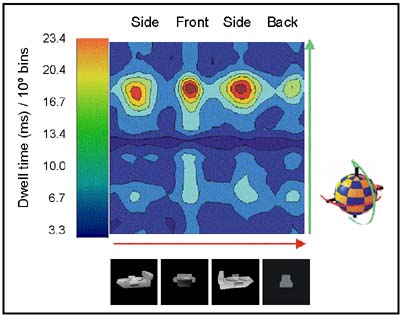

 Some years ago, Keith Humphrey and I, together with our former Ph.D. student, Karin Harman James (now at Indiana University) demonstrated that observers who actively rotated three-dimensional novel objects on a computer screen later showed faster visual recognition of these objects than did observers who had passively viewed exactly the same sequence of images of these virtual objects. In a later experiment, we showed that compared to passive viewing, active exploration of three-dimensional object structure led to faster performance on a ‘mental rotation’ task involving the studied objects. We found that in both studies, observers spent most of their time looking at the 'side' and 'front' views of the objects, rather than the three-quarter views. This strong preference for the ‘plan’ views of an object led us to examine the possibility that restricting the studied views in active exploration to either the plan views or the canonical views would result in differential learning. We found that recognition of objects was faster after active exploration limited to plan views than after active exploration of canonical views. Taken together, these experiments demonstrate (1) that active exploration facilitates learning of the three-dimensional structure of objects, and (2) that the superior performance following active exploration may be a direct result of the opportunity to spend more time on plan views of the object.
Some years ago, Keith Humphrey and I, together with our former Ph.D. student, Karin Harman James (now at Indiana University) demonstrated that observers who actively rotated three-dimensional novel objects on a computer screen later showed faster visual recognition of these objects than did observers who had passively viewed exactly the same sequence of images of these virtual objects. In a later experiment, we showed that compared to passive viewing, active exploration of three-dimensional object structure led to faster performance on a ‘mental rotation’ task involving the studied objects. We found that in both studies, observers spent most of their time looking at the 'side' and 'front' views of the objects, rather than the three-quarter views. This strong preference for the ‘plan’ views of an object led us to examine the possibility that restricting the studied views in active exploration to either the plan views or the canonical views would result in differential learning. We found that recognition of objects was faster after active exploration limited to plan views than after active exploration of canonical views. Taken together, these experiments demonstrate (1) that active exploration facilitates learning of the three-dimensional structure of objects, and (2) that the superior performance following active exploration may be a direct result of the opportunity to spend more time on plan views of the object.
Harman, K.L., Humphrey, G.K., & Goodale, M.A.. (1999). Active manual control of object views facilitates visual recognition. Current Biology, 22, 1315-1318. Download pdf
Harman, K.L., Humphrey, G.K., & Goodale, M.A.. (2001). Manipulating and recognizing virtual objects: Where the action is. Canadian Journal of Experimental Psychology, 55, 111-120. Download pdf